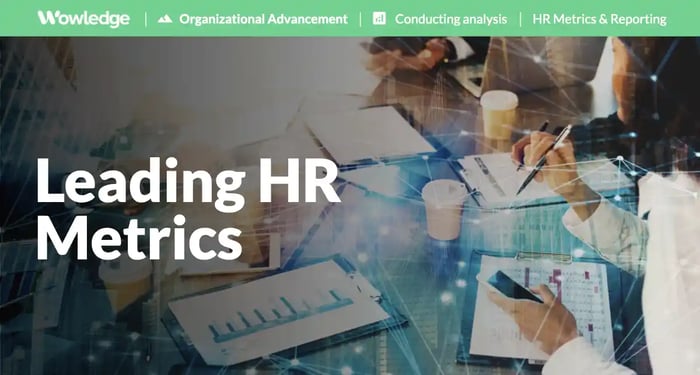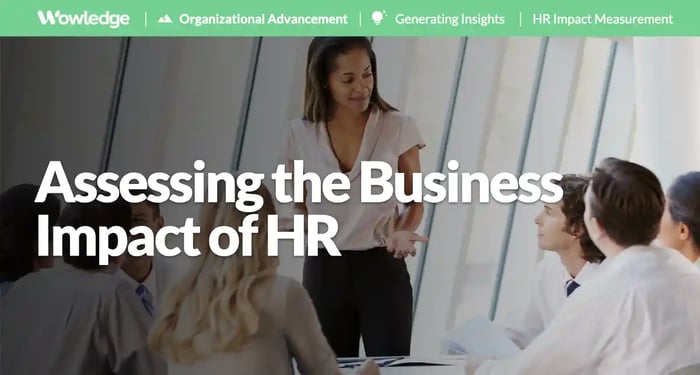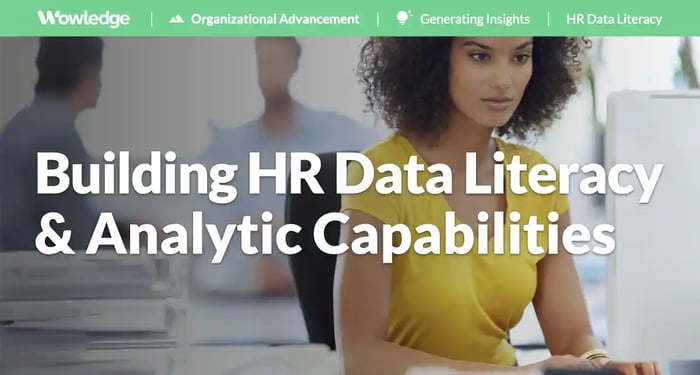Table of Contents
Over many years of designing, developing, and reviewing literally thousands of HR data analytic reports, together with our experts at Wowledge, we have accumulated a lifetime of lessons learned about building and using leading HR metrics and well-constructed reports. During that time, we have often been asked about our “favorite metrics.” Presumably, the requestors seek measures that provide uniquely powerful insights into people or HR contributions to improved talent and business outcomes. The answer to such questions about leading HR metrics has been consistent—the most impactful ones are those that best fit the need and address the challenge being faced at that moment. In other words, “it depends.”
It depends on the specific challenge that is being faced or addressed. Choosing the right leading HR metrics depends on an organization’s business or talent strategies. It depends on the priorities that top business or HR leadership are most concerned about. It depends on the analytic tools, systems, and capabilities to which a given reporting function has access. And it depends on the appetite a leadership team has for certain types of data and insights.
That said, recurring themes arise as the various HR processes and practices that touch so many employees across the full range of industries and organization types tend to have the same or similar steps and desired outcomes. For example, the performance management process, which has certainly evolved over the years (dramatically so in the past ten), is nonetheless devoted to clarifying job requirements, performance expectations and standards, and a provision of feedback designed to motivate and improve worker execution of their role. Following those reasons for existence, the metrics tend to be focused on the proper completion of process steps, satisfaction with the delivery of associated messages, relative ratings provided across employees, and degree of alignment with business or operational results by the unit.
As a result, some identifiable metrics for many of these highly repeated processes and practices can represent “best practice” and leading HR metrics.
The importance and value of HR measurement
Creating an "HR data culture" is crucial to great HR due to the volume and availability of data collected on people-based actions, transactions, preferences, and behaviors. The need is driven by the sheer volume of people being employed and the relative sparseness of HR staff able to directly observe and provide guidance to the managers of others. HR teams are expected to simultaneously guide managers while understanding the “pulse” of the employee mood and temperament relative to business plans, objectives, and directions, so using leading HR metrics is necessary.
Unfortunately, industry research suggests that less than 25% (and as little as 8%) of companies can use the data they have to generate the most fundamental insights into the deployment and management of their employees. At the same time, a study by Bersin by Deloitte in 2017 found that highly mature people analytics organizations enjoyed twice (2X) the revenue, 1.9X cash flow from operations, and 1.8X gross margin or profit than those with low maturity. The value of providing leading HR metrics is clearly there, but the capability is not.
A data-driven HR culture is “the systemic adoption and incorporation of HR and business data to inform decisions about all aspects of people strategies, practices, policies, and programs.” Creating such a capability continues to be an enormous challenge to most organizations. Anecdotal experience from some of the largest and most prestigious global organizations suggests that the struggle is real, even in the most refined and successfully managed companies. The challenges and solutions to advancing an HR analytics capability are numerous. Still, the issues generally fall into three buckets—poor data quality and consistency, HR team skills and literacy, and management expectations/trust.
The value of such a measurement capability lies in the organization's ability to make informed and more objective decisions. That means across HR processes, organizational lines, geographies, and talent and business challenges. Being able to answer questions such as “Why is turnover so high in [business unit or function]?” “To what extent has the new sales compensation program driven revenue growth?” “What factors are causing lowered productivity in production line X?” “How well is the current leadership development program increasing digital and AI leadership skills in our top managers?”. In other words, a quality analytics capability using leading HR metrics provides guidance and insights into the efficacy and value of people-related processes and programs.
What makes a great metric?
Understanding the nature of leading HR metrics will give a structure for thinking about what makes for a robust measure. In essence, three primary outcomes of HR processes, practices, programs, and policies drive the development of metrics: efficiency, effectiveness, and business impact. Efficiency points to the amount of optimization in a process, procedure, or practice – the extent to which it can be accomplished with minimal steps and time commitment. Effectiveness refers to the degree to which a practice, process, program, or method accomplishes what it is designed to do. Business impact (often neglected by HR reporting teams) reveals the program or process's role in supporting or delivering the business or operational objective.
A great metric is also characterized by its value in decision-making—its usefulness and understandability. This drives the definition of leading HR metrics towards using "trends" versus “place in time” measures. While some metrics make sense as a one-shot metric (impact on year-end sales, annual turnover rate), most often, a trended view provides a more realistic assessment given the flow of employees through an organization—the steady volume of movement of new hires, transfers, terminations, and retirements tend to change the nature of the employee base whose varying perspectives, perceptions and expectations can have a significant impact on measured outcomes.
Furthermore, leading HR metrics tend to gain value when viewed from end-users' perspectives. Measures that matter to managers are understandable and meaningful to their day-to-day decisions and actions and tend to be indicators of desired talent outcomes. For example, “cost-per-hire” is less meaningful to managers who often do not own recruiting budgets. They are more likely to care about the volume of qualified candidates provided to them in a timely manner; as such, those process metrics can help them understand the extent to which the talent acquisition team is either meeting their needs or facing challenges. Top leaders tend to care less about measures of HR process efficiency and are more likely to care about staffing and hiring levels relative to headcount and production budgets.

How to measure what matters to leaders, managers, and HR professionals
Identifying impactful and meaningful measures is the output of proactive inquiry and experience. Starting with top executives and working one’s way through the management ranks with interviews and focus groups to develop a list of questions and trends that leaders and managers are asking or interested in. Next, conduct similar inquiries with HR leaders, especially those in either HRBP or specialist (e.g., L&D, talent acquisition, compensation) leadership roles. The key is to understand the unique information needs and preferences of key audience segments and develop listings of metrics that matter to each segment. Ideally, unique dashboard versions can be presented to each segment (e.g., top executives, functional leaders, HR teams, middle managers). The value of the selected metrics is enhanced significantly by developing and presenting metrics that integrate HR and business data and leverage predictive analytic techniques.
Leading HR metrics for major processes, practice areas, and critical talent challenges can then be generated and presented according to the preferences and needs of each group of end users. Examples of those include:
Key HR Processes and Capabilities
HR Strategy
- HR Expense to Revenue Ratio: The cost of HR operations relative to total revenue
- HR Staffing Ratio: Number of HR professionals per 100 employees
Organizational Design
- Average Manager span of control: Total managers/Total employees
- Organizational Depth: Number of management layers between the CEO and lowest-ranking employee
Workforce Planning
- Workforce Demographics: Percentage of total workforce by role and job level by age, gender, ethnicity, etc.
- Attrition: Total turnover rate (voluntary + involuntary + retirements) / Average employee headcount in same period
- Net Hiring: Number of hires minus Number of employee terminations
- Future Skill and Talent Gaps: Number of employees in critical skill roles vs. estimated number needed to meet future operational requirements
- Contingent Labor Ratio: Number of contract workers/Full-time employees
Recruiting Strategy and Sourcing
- Quality of Hire: Average performance rating and retention rates of new hires
- Time to fill: Time lag between job posting and new hire start date
- Source of Hire ROI: Number of hires, cost per hire by source (e.g., social media, job board, employee referral, passive candidate conversions, etc.)
- Recruiting effectiveness: Offer acceptance rate, interviewed candidates per requisition
Learning and Development
- Training Completion Rates: Percentage of employees completing assigned training
- Skill Acquisition Rate: Post-learning skill level assessment (e.g., average score on post-course skill test)
- Competency Rating Growth: Average functional competency model score after the course or program completion (typically assessed and collected annually by the manager in the performance management process)
Performance Management
- Goal Achievement Rates: Percentage of employees meeting or exceeding their performance goals
- Performance Improvement: Average improvements in performance scores by function, department, or manager
- Performance Review Completion: Rate of timely completion of performance review processes
Career Development
- Employee mobility rate: Cross-department, function, or location transfers/Total employees
- Average role tenure: Average years in the role
Coaching and Mentoring
- Coaching engagement rate: Number of employees engaged with a coach or mentor/Total number of employees
- Promotion or Mobility Rate: Percentage of coached/mentored employees who are promoted or transferred/Total number of coached/mentored employees
- Competency enhancement rate: Average leadership competency model rating changes for coached/mentored employees
Leadership Development
- Average Leadership Competency Rating: Average of all assessment scores of leadership competencies
- Success Rate of Leadership Programs: The effectiveness of leadership development programs as measured by post-course observations, competency rating growth, or operational result improvements
- HiPo Development Rate: Number of named high potentials with formal development plans/total employees at the same level
Succession Management
- Leadership Pipeline Strength: Percentage of key and critical roles with named, ready-now (or <1 year) successors able to move into leadership roles
- Succession Planning Rate: The percentage of key roles with one or more unique (e.g., not identified as successors to multiple roles) identified successors
- Succession Promotion Rate: Percentage of open key and critical roles where the job was filled by a named successor/Total filled key and critical roles
Diversity, Equity, and Inclusion
- Demographic diversity rate: Percentage of employees with diverse backgrounds or profiles/Total employees
- Diversity management utilization rate: Percentage of diverse employees in management roles
Organizational Change Management
- Employee Adoption Rate: The rate at which employees adopt new targeted changes or systems
- Change Impact Score: Measurement of the impact of change on work processes (e.g., processing time, accuracy, or quality) and outcomes or employee performance (e.g., lowered error rates, increased customer satisfaction)
Critical Talent Challenges
Employee Experience
- Employee Satisfaction: Average ratings on post-use surveys (e.g., after using a system, requesting information, onboarding, completing the performance evaluation process, etc.)
- Turnover rate: (Voluntary + Involuntary + Retirements) / Average employee headcount in the same period
- Employee net promoter score (eNPS): Average score of employees surveyed “would recommend this as a place to work” (typically on q 1-5 scale)
Employee Wellness and Well-being
- Illness/Absenteeism Rate: Average lost days (employee sick day usage/absenteeism rates)
- Wellness Utilization Rate: Psychological benefits/EAP utilization rates
Managerial Effectiveness
- Manager Effectiveness: Average "upward feedback" ratings from subordinates
- Employee engagement: Percentage of employees who answer positively (e.g., 4-5) on an engagement survey scale of 1 (low) to 5 (high)
Lessons learned on HR metrics
The listing of leading HR metrics above is meant to be instructive and illustrative but not comprehensive. Identifying the “right” measures for reporting should be a byproduct of experience and end-user input. The key is to provide actionable insights into talent trends and the impacts on processes. As a result, HR professionals should plan and schedule regular reviews of the utility of each metric and analysis included in a report.
Several “lessons learned” emerge from the experiences of HR leaders and consultants who are experts in designing, delivering, and acting on leading HR metrics and analytics. Those lessons include:
1. Trended data rules
Analyses that show data over a period—weeks, months, years—can reveal naturally occurring or event-responsive trends that can inform the true nature of an issue. For example:
- Increased turnover within a month or two after the annual performance process is completed can provide insights into employee dissatisfaction with the process or with the manager's delivery. Follow-up surveys and interviews can reveal changes to improve perceptions and mitigate damage from poor execution.
- Lowered hiring and longer times-to-fill in the summer are common results of candidates and hiring managers taking vacations. Planning for increased activity and focus on the spring and fall months can help fill the expected shortfall and maintain staffing plan requirements.
- Engagement scores that dip after a reorganization or layoff can reveal employee nervousness and a loss of confidence in their job stability. Such corporate actions in the future can anticipate and plan for this by proactively using communications and change management tactics to blunt the negative impacts of an otherwise disruptive event.
2. Presentation matters
Graphic representations, or dashboards, provide easier-to-digest, easier-to-interpret reporting. Leaders and Managers have many reports to review from the full range of corporate functions, so those from HR must stand out as easy to review and identify key trends that are impacting their ability to conduct business. Plan to formally review reports with their key audiences regularly (e.g., annually) and place the most impactful graphs, tables, and charts at the top or front of the report for easy access.
3. Provide context
Reports should always include easy-to-understand clues about the context or “what is or is not good” for the results reported. Label tables, charts, and graphs using scales (e.g., 1-5) and anchors (e.g., 1=Poor, 5=Excellent). Even better, include a trend line over weekly or monthly data (bars, dots) so an annual trend is easily observed. A best practice is to include verified benchmarks from reliable industry or national sources to easily compare “where we stand.”
4. Validate the accuracy of the data
Always review the raw data to ensure it has the necessary integrity. Take the time to look for instances of missing, incomplete, duplicate, or improperly formatted data before running reports. Validate the date range and selected fields, especially when using data downloaded from a source system into a spreadsheet, database, or other data repository. “Garbage in, garbage out” is an avoidable circumstance.
5. Segment the results
Prepare reports that are relevant to the questions being answered and the audience to which they are being presented. Functional leaders should only be presented with data related to the employees under their command, and likely with an enterprise-wide view for comparison’s sake. Maintain privacy by providing only those employee details to their direct managers. Create segmented analyses that enable homing in/drilling down on critical employee groups to identify hot spots that require management attention; for example, turnover data that focuses on critical skills employees, diversity employees, or those in a particular location or management chain. Going deeper into the details allows pinpointing trends that might not be otherwise visible.
Relevant Practices & Tools
Core HR Metrics and Reporting Practices to Establish a Robust HR Decision Support Capability. >
The structured measurement and presentation of employee and human resources process data that provides quantitative insights to drive objective and educated decision-making... more »
Advanced HR Metrics and Reporting Practices to Increase the Consistency and Quality of HR and Functional Leaders' Decision Making. >
Advanced Metrics and Reporting broaden the spectrum of data used to provide more robust and refined insights that drive enhanced decision-making by HR and functional leaders... more »
Emerging HR Metrics and Reporting Practices to Drive Situation Assessment and Actionable Insights for Managers and Leaders. >
HR Metrics & Reporting is a standardized and structured experience for both developers and users of the data and reports. A crucial element is the development of a "data culture"... more »
Generating More Robust Workforce Planning Insights With Advanced Statistical Analyses. >
Leveraging advanced analytics to establish the future-based likelihood of headcount gains and losses is a multi-faceted approach to emerging workforce planning... more »
The Process to Outcomes Translation Tool: Convert HR Strategies and Processes into Representative Metrics. >
The Process to Outcomes Translation tool is designed as a guide to creating metrics that represent HR's impact on the business... more »
FAQs
How should an organization define “leading” versus “lagging” HR metrics in practice?
Leading metrics indicate conditions that predict or are likely to shape outcomes, such as hiring-funnel sufficiency or certification program completions for critical skills, while lagging metrics record crucial outcomes that have already occurred, such as turnover or time-to-productivity. A practical approach maps each lagging KPI to two or three leading indicators with plausible causal pathways. This pairing lets leadership intervene earlier and test whether changes to upstream drivers shift downstream results.
What governance is needed to keep HR metrics consistent and credible across units?
A data governance council should own data dictionaries, metric definitions and calculation methods, and change control. Standardized logic, data and report refresh cadences, and exception rules prevent locally-derived variations of reporting from eroding trust. Centrally-generated metrics and a dashboard, supported by quarterly audits and dashboard certifications, create a single source of truth while allowing controlled local drill-downs of the metrics and analyses.
How can HR teams raise data literacy among managers quickly?
Short, role-based micro-lessons tied to live dashboards are more effective than generic training. Each session should explain one metric, show how it is calculated, and walk through a real decision influenced by that metric. Office hours and annotated dashboard tooltips reinforce learning in the flow of work.
What benchmarks are most useful for HR metrics without encouraging unhealthy comparisons?
External benchmarks work best for process efficiency and labor-market conditions, while internal historical and peer group benchmarks are superior for behavior and culture measures. A balanced set includes a three-year internal trend, a comparable internal cohort, and one vetted external reference. The emphasis stays on directional improvement rather than league tables.










